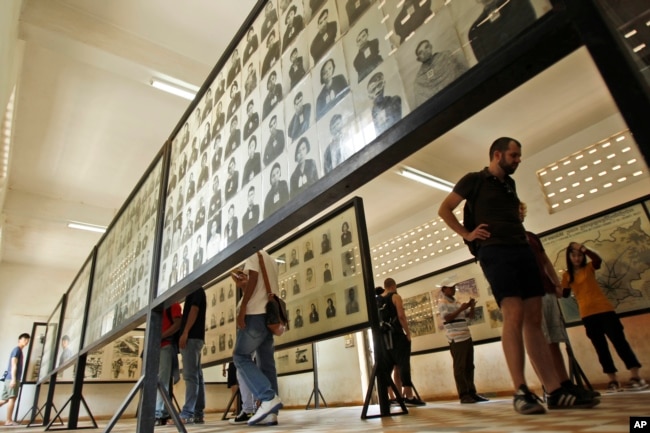Annie
Diamond Member
- Nov 22, 2003
- 50,848
- 4,828
- 1,790
A little lightheartedness and a new catch word!
http://www.dailypundit.com/archives/014899.php#014899
http://www.dailypundit.com/archives/014899.php#014899
Follow along with the video below to see how to install our site as a web app on your home screen.
Note: This feature may not be available in some browsers.
Chhour Sokty, director at Choeung Ek, the best known of the sites commonly called The Killing Fields, said visitor numbers had leaped to as many as 800 a day since he began working here 11 years ago, with media promotions leading to increased numbers of tourists, who are helped by vastly improved roads and amenities like public toilets. “I was in charge here in 2005 when there were only about 100 to 200, or a maximum 300 visitors per day. But now it is about 700 to 800 per day during high season,” he said.
Genocide tourism
Each day at Choeung Ek, 17 kilometers south of Phnom Penh, tourists arrive by tuk-tuk (three-wheeled taxi), motorbike and air-conditioned coaches. The attraction is macabre; skulls stacked neatly in a stupa (dome-shaped monument) surrounded by mass graves where thousands were bludgeoned to death, usually with an ox-cart axle, and buried — all victims of the 1975-1979 mass killings by Pol Pot’s henchmen. “Most people from around the world have heard about that black period in Cambodia, which killed almost 2 million people,” said Kob Kalyaney who works for a private tour agency. “Tourists want to learn if the history is real and they want to witness it,” she said.

Foreign tourists walk through Choeung Ek stupa, which stores thousands of human bones and skulls of the Khmer Rouge's victims in the outskirt of Phnom Penh, Cambodia
There are hundreds of sites across Cambodia like Choeung Ek. The difference is that here, and at the S-21 extermination camp in Phnom Penh, admission is charged, bringing in a tidy income. Booksellers, street vendors, tuk-tuk drivers, tour companies and beggars all do a brisk trade.
Leaving a mark
And too many tourists have left their mark. Some scribble graffiti on prison walls at S-21, site of the Tuol Sleng Genocide Museum where Pol Pot’s victims were processed before being sent to the Killing Fields. Buildings, prison cells and grisly displays of paintings and photographs, along with instruments of torture, have been displayed for daily crowds. At Choeung Ek, some innocently tie ribbons and notes to the mass graves, but others collect bone fragments, smoke and eat on the steps of the bone-filled stupa and ignore rules regarding the use of cameras and silence.

Tourists view portraits of victims executed by the Khmer Rouge regime at the Tuol Sleng Genocide Museum, formerly a notorious Khmer Rouge prison, in Phnom Penh, Cambodia
Youk Chhang, executive director of the Documentation Center of Cambodia (DC-Cam), said Western tourists arrived here with an abstract mindset that avoids unnecessary displays of violence while Asian visitors expect to see blood and graphic evidence of what happened. He said it was a mix that needed to be catered to, but stressed that neither Choeung Ek nor the S-21 site in Phnom Penh, a former school, were businesses run for profit. “We should preserve for our children not for the tourists. But tourists are welcome if they want to visit, if they want to see it, they want to understand it, they’re welcome. That’s the whole purpose of the preservation of the site,” he said.

Cambodian villagers line up to enter a courtroom before the first appeal hearings against two former Khmer Rouge senior leaders, Khieu Samphan and Nuon Chea, at the U.N.-backed war crimes tribunal in Phnom Penh, Cambodia
He said a lack of information was partly to blame for inappropriate behavior and that tourists were not aware of the rules and recently introduced regulations. But he added that photos of Khmer Rouge leaders on the exhibition walls of Choeung Ek were often replaced because of graffiti. “People get so upset when they see the photograph of the Khmer Rouge leaders so they write on it. ... I think that it can be bad, it can be good,” he said. “You cannot stop people from being, feeling upset.”
Evidence and a sanctuary